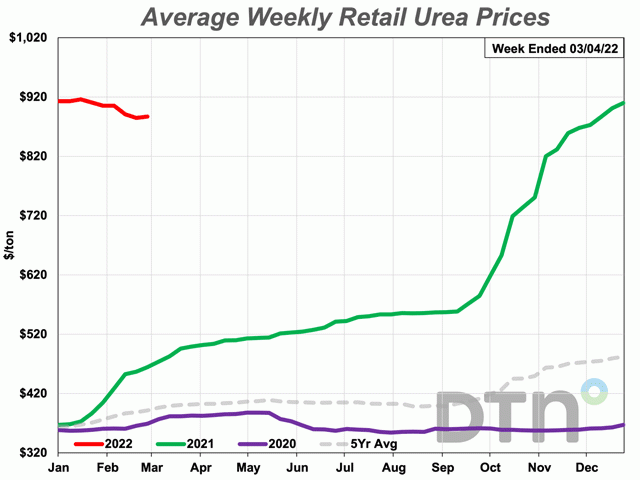November 27, 2025 | 20:33 GMT +7
November 27, 2025 | 20:33 GMT +7
Hotline: 0913.378.918
November 27, 2025 | 20:33 GMT +7
Hotline: 0913.378.918

Urea was the only fertilizer with a slightly lower average retail price compared to the prior month. Urea had an average retail price of $887 per ton the first week of March, down $18 from $905 the first week of February. (DTN chart)
After a week in which half of the average retail fertilizer prices were lower, prices for most fertilizers moved higher the first week of March 2022 compared to a month earlier, according to sellers surveyed by DTN.
Seven of the eight major fertilizers were higher looking back a month, though none were up a significant amount. DTN designates a significant move as anything 5% or more.
DAP had an average price of $879 per ton, MAP $937/ton, potash $815/ton, 10-34-0 $837/ton, anhydrous $1,487/ton, UAN28 $603 (all-time high price) and UAN32 $703/ton (all-time high price).
One fertilizer was slightly lower in price compared to the prior month. Urea had an average price of $887/ton.
On a price per pound of nitrogen basis, the average urea price was at $0.96/lb.N, anhydrous $0.91/lb.N, UAN28 $1.08/lb.N and UAN32 $1.10/lb.N.
Brazil is looking for a new fertilizer supplier as the war in Ukraine threatens to cut off shipments of nutrients to the South American agriculture giant, Dow Jones reported.
Brazil imports about 85% of its fertilizer needs and about a fifth of those imports come from Russia. Russia's trade ministry has called for the suspension of fertilizer exports.
Even before the conflict, there were numerous issues with global fertilizer supply. Higher natural gas prices, a lower supply from China and weather issues curtailing U.S. production all came together in 2021 to reduce supply, thus raising world fertilizer prices.
The war in Ukraine has made this situation worse, according to industry analysts.
Dow Jones reported that Brazilian Agriculture Minister Tereza Cristina Dias said she is planning to travel to Canada this month to hopefully secure more fertilizer supplies. Dias said Brazil has enough stocks to last until October, although some don't agree with this statement.
The Brazilian National Fertilizer Association has warned local fertilizer stocks will only last another three months. Sanctions and travel restrictions have hampered shipments to Brazil, the group said.
"We are experiencing firsthand what it means to depend on imported fertilizer," Jefferson Souza, a Brazil-based fertilizer analyst at Agrinvest Commodities, told Dow Jones.
Sluggish productivity has kept the country from developing a larger domestic fertilizer industry, he said.
Most fertilizers continue to be considerably higher in price than one year earlier.
MAP is now 39% more expensive, DAP is 44% higher, 10-34-0 is 50% more expensive, urea is 87% higher, potash is 96% more expensive, UAN32 is 131% higher, UAN28 137% is more expensive and anhydrous is 166% higher compared to last year.
DTN surveys more than 300 retailers, gathering roughly 1,700 fertilizer price bids, to compile the DTN Fertilizer Index each week. In addition to national averages, MyDTN subscribers can access the full DTN Fertilizer Index, which includes state averages.
MORE STRESS FOR FERTILIZERS
The actions of Russia will affect the global fertilizer market, as 90% of all fertilizer is consumed outside of the United States, according to TFI.
Russia is the second-largest producer of ammonia, urea and potash and the fifth-largest producer of processed phosphates. The country accounts for 23% of the global ammonia export market, 14% of urea, 21% for potash and 10% of the processed phosphates.
TFI also points out that the conflict will put stress and uncertainty on the energy market. Russia supplies about one-third of Europe's natural gas supply, the main feedstock to produce nitrogen fertilizers.
"Because of Russia's large fertilizer production and its role as a global fertilizer supplier, the removal of Russian production from the global marketplace will have an impact on supply," the news release said. "Despite the benefits afforded by a robust U.S.-based fertilizer industry, prices for our products are driven by global supply and demand factors."
In a call on Tuesday morning, RaboResearch farm input analyst Samuel Taylor said that while we don't know exactly how fertilizers will be affected by this conflict, there are two obvious areas: production and export of fertilizers that come from the region, and the flow of natural gas.
Ammonia and potash are two fertilizers at most risk. Taylor pointed out that urea, because it's a dry product, has good shipping flexibility versus a product like ammonia, which has a very ridged structure.
"One of the interesting bits about ammonia is it's transported from a pipeline from Russia down into the Black Sea, and that has actually been shut off in the eastern part of Ukraine," Taylor said. "That is a state-owned pipeline."
(DTN)

(VAN) A new study reveals how the simultaneous effects of ocean acidification, salinity and loss of oxygen are making the world more fragile.

(VAN) Hopes are growing that the creation of the first 3D turkey gut model could be a turning point in the battle against the virulent blackhead disease.

(VAN) Tyson, America’s biggest meat supplier, plans to shutter one of its largest beef processing plants as the industry continues to struggle with low cattle supplies and political pressure from Washington.

(VAN) New FAO study shows how digital solutions are empowering farmers and fishers to prevent losses and build resilient agrifood systems.

(VAN) Brazil's COP30 presidency pushed through a compromise climate deal on Saturday that would boost finance for poor nations coping with global warming but that omitted any mention of the fossil fuels driving it.

(VAN) Poultry farmers in the UK have been warned that they could face one of the worst winters yet for bird flu.

(VAN) Prices of main-crop paddy have risen sharply, with jasmine rice hitting 16,100 baht per tonne — the highest level in years.